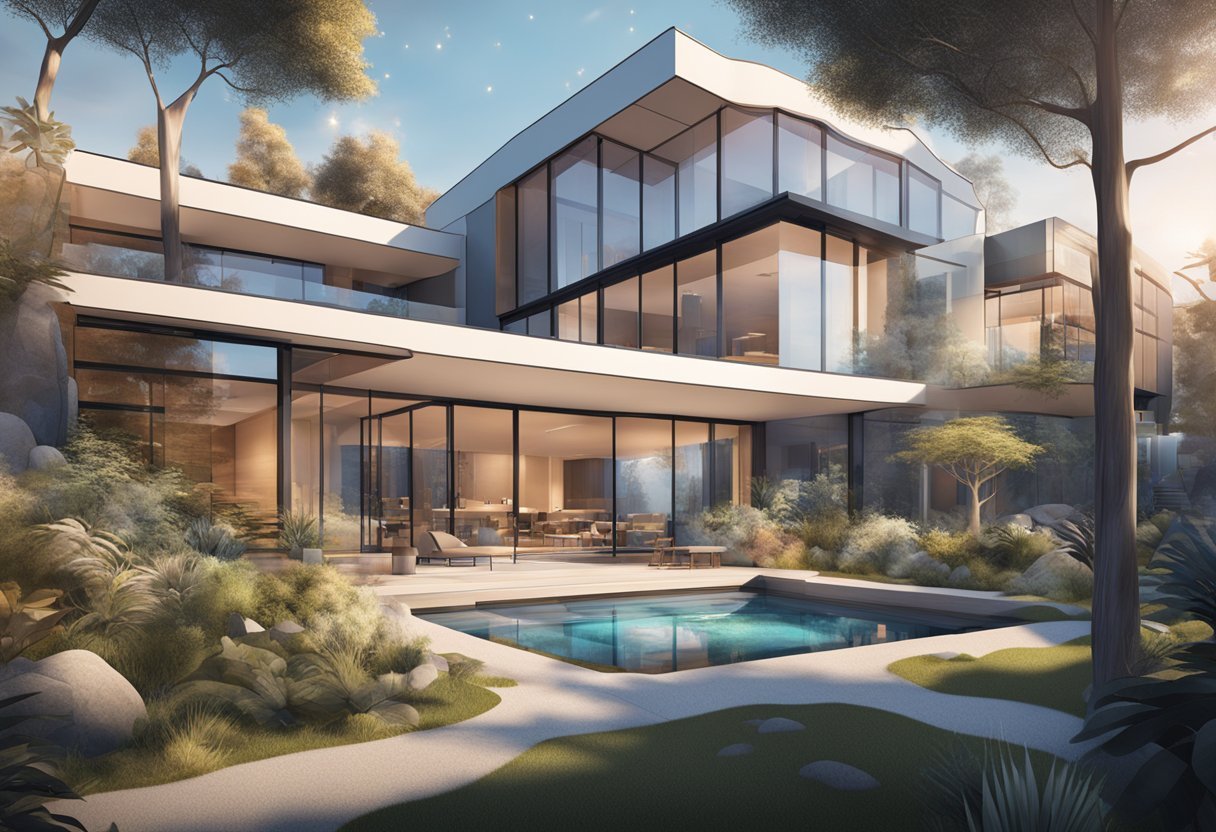Metaverse architecture is an emerging field that involves designing virtual environments and buildings within the metaverse, a term used to describe a collective virtual shared space. The metaverse is a digital world that is created by combining virtual reality, augmented reality, and other immersive technologies. It is a space where people can interact with each other, engage in commerce, and consume media.
As the metaverse continues to grow, architects and designers are starting to explore the possibilities of designing buildings and spaces within this virtual world.
They are using tools such as digital twins, NFTs, and VR/AR/MR to create immersive and interactive environments that can be experienced by people from all over the world. The metaverse provides architects with a unique opportunity to explore new forms of design and to push the boundaries of what is possible in the built environment.
Foundations of Metaverse Architecture
What is a Metaverse Architect?
A metaverse architect is a professional who designs and creates virtual worlds that can be accessed by users through the internet. They use a combination of architectural principles, computer graphics, and programming skills to create immersive environments that simulate real-world experiences.
A metaverse architect must have knowledge of architecture, virtual reality, and augmented reality to create a seamless experience for the user. They must also have an understanding of the technical aspects of the metaverse, including the software and hardware required to run it.
Evolution of Virtual Spaces
Virtual spaces have been around for decades, but the metaverse represents a new era of virtual reality. The metaverse is a shared virtual space where users can interact with each other and the environment. It has become a popular platform for gaming, socializing, and even commerce.
The evolution of virtual spaces has led to the development of new technologies, such as augmented reality (AR) and virtual reality (VR), which have made it possible to create more immersive experiences.
Role of AR and VR
AR and VR have played a significant role in the development of metaverse architecture. AR technology allows users to overlay digital information onto the real world, while VR technology creates a completely immersive experience.
The combination of these technologies has made it possible to create virtual environments that are almost indistinguishable from the real world.
Metaverse architects must have a thorough understanding of AR and VR technology to create immersive and engaging virtual environments. They must also be able to integrate these technologies seamlessly into their designs to create a cohesive experience for the user.
Design Principles in the Metaverse
The Metaverse is a virtual world that is constantly evolving, and designers are tasked with creating spaces that are both functional and visually appealing. In order to do this, there are certain design principles that must be followed.
Influence of AI on Design
Artificial intelligence (AI) has had a significant impact on the design process in the Metaverse. AI can be used to generate designs that are both efficient and aesthetically pleasing. Additionally, AI can analyze data to determine user behavior and preferences, which can inform design decisions.
Designers can also use AI to create personalized experiences for users. For example, AI can analyze user data to determine their preferences and then create a customized environment that caters to those preferences.
Zaha Hadid Architects’ Contribution
Zaha Hadid Architects has made significant contributions to the field of Metaverse architecture. The firm’s designs are characterized by their organic shapes and futuristic aesthetic. The firm has also incorporated sustainable design principles into their Metaverse designs.
One of the firm’s most notable Metaverse projects is the Galaxy SOHO complex, which features four interconnected towers that are designed to resemble planets. The complex is designed to be both visually stunning and functional, with spaces for offices, retail, and entertainment.
The design principles in the Metaverse are constantly evolving as technology advances and user preferences change. Designers must be able to adapt to these changes in order to create spaces that are both functional and visually appealing.
Building the Digital World
Building in the metaverse requires a different approach than traditional construction. Architects and builders must consider the unique challenges of constructing virtual environments that are both functional and visually appealing.
Constructing Virtual Environments
To build in the metaverse, architects and builders first need access to a metaverse platform. Popular platforms include Sandbox, Cryptovoxels, and Decentraland. These platforms offer users the ability to create and design virtual environments using a variety of tools and resources.
Virtual environments must be designed with the user in mind. Builders must consider how users will interact with the environment, and how they will navigate through it. This requires an understanding of user experience design and interface design principles.
Digital Twin Technology
Digital twin technology is an emerging trend in metaverse architecture. This technology allows architects and builders to create a digital replica of a physical structure. This can be used to test and refine designs before construction begins, and can also be used to create virtual replicas of existing buildings.
Digital twins can also be used to monitor and manage physical structures. Sensors can be placed in a building to collect data on its performance, which can then be used to optimize energy usage and reduce maintenance costs.
In conclusion, building in the metaverse requires a unique set of skills and considerations. Architects and builders must understand user experience design and interface design principles, and must be familiar with metaverse platforms and digital twin technology.
With these skills and tools, they can create functional and visually appealing virtual environments that meet the needs of their users.
How to Become a Metaverse Architect
Becoming a Metaverse architect requires a specific set of skills and knowledge. Here are the steps to become a Metaverse architect:
- Gain Proficiency in Virtual Reality (VR) and Augmented Reality (AR) Technologies: Metaverse architects should have a strong understanding of VR and AR technologies. They should be able to design and develop immersive virtual environments that can be experienced by users.
- Develop Computational Design Skills: Computational design skills are essential for Metaverse architects. They should be able to use computational design tools to create complex virtual environments and structures.
- Learn Programming Languages: Metaverse architects should have a good understanding of programming languages such as C++, Python, and Java. This will help them to develop and implement complex algorithms and create interactive virtual environments.
- Gain Experience in 3D Modeling: Metaverse architects should have a good understanding of 3D modeling tools such as Blender, Maya, and 3DS Max. This will help them to create realistic virtual environments and structures.
- Stay Up-to-Date with the Latest Technologies: Metaverse architects should stay up-to-date with the latest technologies and trends in the field. They should be able to adapt to new technologies and incorporate them into their work.
By following these steps, one can become a proficient Metaverse architect. It takes time, dedication, and hard work to develop the necessary skills, but the end result is a rewarding career in a rapidly growing field.

Metaverse architecture projects
Metaverse architecture is a rapidly growing field, and there are numerous projects that are pushing the boundaries of what is possible in the virtual world. Here are the top five Metaverse architecture projects:
1. Decentraland
Decentraland is a decentralized virtual world that allows users to create, experience, and monetize content and applications. It is built on the Ethereum blockchain and uses a custom scripting language called Solidity. The platform has its own marketplace where users can buy and sell virtual land, as well as a variety of tools for building and customizing their virtual space.
2. Somnium Space
Somnium Space is a virtual reality platform that allows users to create and explore immersive virtual environments. It is built on the Ethereum blockchain and uses a custom cryptocurrency called SOMN. The platform has its own marketplace where users can buy and sell virtual land, as well as a variety of tools for building and customizing their virtual space.
3. Cryptovoxels
Cryptovoxels is a virtual world built on the Ethereum blockchain that allows users to create, explore, and monetize virtual spaces. The platform uses a custom voxel-based design system that allows for easy creation and customization of virtual spaces. Users can buy and sell virtual land and assets on the platform’s marketplace.
4. The Sandbox
The Sandbox is a virtual world that allows users to create, share, and monetize their own gaming experiences. It is built on the Ethereum blockchain and uses a custom cryptocurrency called SAND.
The platform has a variety of tools for building and customizing virtual spaces, and users can buy and sell virtual land and assets on the platform’s marketplace.
5. NeosVR
NeosVR is a virtual reality platform that allows users to create and explore immersive virtual environments. It has a wide variety of tools for building and customizing virtual spaces, as well as a marketplace where users can buy and sell virtual assets. The platform supports a variety of devices, including VR headsets and traditional monitors.
Metaverse Architecture Software
Metaverse architecture software plays a critical role in designing and constructing virtual environments within the Metaverse.
These software tools help architects create immersive and interactive digital spaces that can be experienced by users in real-time through various devices such as computers, virtual reality headsets, or smartphones.
Here are the top 5 Metaverse architecture software tools:
1. Unity
Unity is a popular game engine that has become a go-to tool for Metaverse architects. It provides a wide range of features and functionalities that enable architects to create complex virtual environments with ease. Unity’s powerful scripting capabilities allow architects to create custom behaviors and interactions for their virtual objects.
2. Unreal Engine
Unreal Engine is another popular game engine that is widely used in Metaverse architecture. It provides a robust set of tools for creating high-quality, immersive virtual environments. Unreal Engine’s visual scripting system, Blueprint, allows architects to create complex interactions without writing a single line of code.
3. Blender
Blender is a free and open-source 3D creation software that is widely used in Metaverse architecture. It provides a powerful set of tools for creating 3D models, animations, and visual effects. Blender’s intuitive interface and extensive documentation make it an excellent choice for architects of all skill levels.
4. SketchUp
SketchUp is a 3D modeling software that is widely used in architecture and design. It provides a simple and intuitive interface that allows architects to quickly create 3D models of their virtual environments. SketchUp’s extensive library of plugins and extensions makes it a versatile tool for Metaverse architects.
5. Maya
Maya is a 3D animation and modeling software that is widely used in the film and gaming industries. It provides a powerful set of tools for creating complex virtual environments with realistic lighting and physics. Maya’s scripting capabilities and extensive library of plugins make it a popular choice for Metaverse architects.
In conclusion, Metaverse architecture software plays a critical role in creating immersive and interactive virtual environments within the Metaverse.
The software tools listed above are some of the most popular and widely used in the industry. Architects can choose the tool that best suits their needs and skill level to create stunning virtual environments that can be experienced by users around the world.
Frequently Asked Questions
What qualifications are necessary to pursue a career as a metaverse architect?
A degree in architecture or a related field is essential to become a metaverse architect. One must also be proficient in 3D modeling software, game engines, and programming languages.
Knowledge of virtual reality, augmented reality, and mixed reality is also necessary. As the field is still evolving, it is important to keep up with the latest developments and trends.
What are the essential skills required for designing within the metaverse?
Metaverse architects need to have a strong understanding of spatial design, user experience design, and interactive design. They should have an eye for detail, be able to work in a team, and have excellent communication skills. The ability to think creatively and outside the box is also important.
How does metaverse architecture differ from traditional digital design?
Metaverse architecture is a new field that combines elements of architecture, game design, and virtual reality. Unlike traditional digital design, metaverse architecture involves designing virtual spaces that are interactive and immersive. Metaverse architecture also requires a deep understanding of user experience design and the psychology of virtual environments.
Can you explain the role of parametric design in the context of the metaverse?
Parametric design is a design process that uses algorithms to create complex geometric shapes and patterns. In the context of the metaverse, parametric design enables architects to create intricate virtual environments that are both aesthetically pleasing and functional. Parametric design also allows for the creation of dynamic spaces that can adapt and change based on user input.
What are the emerging job opportunities in the field of metaverse architecture?
As the field of metaverse architecture continues to grow, there will be a demand for architects, designers, programmers, and artists. Job opportunities include metaverse architect, user experience designer, game designer, 3D modeler, and programmer. There will also be opportunities in related fields such as virtual reality, augmented reality, and mixed reality.
What events showcase the latest developments in metaverse architecture, such as the Metaverse Architecture Biennale?
The Metaverse Architecture Biennale is a major event that showcases the latest developments in metaverse architecture.
Other events include the Virtual Futures Salon, the Virtual Reality Developers Conference, and the SIGGRAPH Conference. Online communities such as the Metaverse Roadmap and the Metaverse Alliance also provide opportunities to stay up-to-date on the latest developments in the field.




